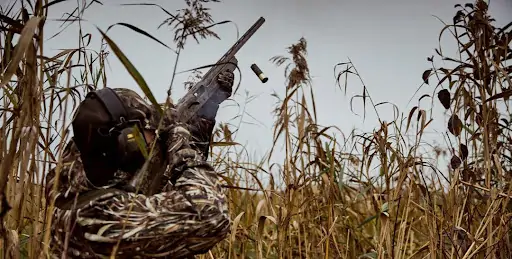The lead shot ban has been in effect since February 15, 2023. Hunting in and around wetlands with shotgun ammunition containing lead is therefore prohibited. The legal basis arises from the so-called REACH regulation. The regulation is essentially aimed at companies and is intended to contribute to or improve human health and the environment. The use of lead in all areas of life – including hunting – should be checked and reduced. Therefore, in the future only lead-free shot should be used when hunting in and 100m around wetlands.
According to the regulation, wetlands are “wet meadows, moorland and swamp areas or water bodies that are natural or artificial, permanent or temporary, stagnant or flowing, and consist of fresh, brackish or salt water, including those marine areas that have a depth of six meters “Do not exceed low water levels”.
In short: every (temporary) water-bearing ditch in the area, no matter how small, will be considered a wetland in the future. After an interim clarification, puddles are not included because they are temporary and do not represent a habitat for water birds. A particularly sensitive point in the new regulation is the reversal of the burden of proof to the detriment of the hunter. This means that a hunter who carries lead shotgun ammunition in or near wetlands must prove that he did not use or intend to use that ammunition there.
The situation during an inspection is interpreted as meaning that a hunter who carries lead shotgun ammunition in or near a wetland also wants to use it in the wetland or buffer zone. So far, fines have been imposed for violations. It will be exciting to see how the case law develops after the first “lead-free” hunting season is over. However, there is no general ban on lead shot. In addition to the regulation, national regulations must also be kept in mind.
A particularly sensitive point in the new regulation is the reversal of the burden of proof to the detriment of the hunter.
Lead-free shotgun ammunition is not always made of steel but can also be made of zinc, copper, bismuth, soft iron or tin. Some manufacturers also offer cartridges with a combination of different materials. Bismuth is an expensive alternative and, according to some users, comes closest to the effect of lead.
Older weapons often do not have the necessary steel shot, which can be recognized by the fleur-de-lis. If a shotgun/combined weapon does not have steel shot but only normal fire, then, according to the Ulm Proofing Office, normal soft iron cartridges with a shot thickness of up to 3.25 mm and a gas pressure of up to 1050 bar can be fired in a 12-gauge shotgun. Click here to check out its stripped lowers.
There is a limit of 3 mm for a standard 16 caliber shotgun. Lead-free shotgun ammunition ≤ 2.6 mm may be used in caliber 20/70. Alternatively, bismuth (bismuth) shot can easily be fired from shotguns/combined arms without steel shot. However, this does not apply to the other lead-free materials. If you would like to take a closer look at the matter, the DJV offers a video series on YouTube on how to handle lead-free shotgun ammunition. The videos present technical details and draw on practical experiences, where lead shot has not been allowed to be used for hunting since 1996. When shooting, it is recommended to choose shotgun ammunition two sizes larger and reduce the shooting distance to 25 to 30 meters. Before the fall hunts, everyone should try out the new cartridges in order to be able to fire a shot that is appropriate for hunting.
CROW HUNTING WITH A FRIENDLY DECOY IMAGE

In recent decades, many hunters have only looked at crow hunting with a decoy image with a weary smile. Things are different today – it has long been shown that hunting raven-like birds is not only extremely exciting and challenging, but can also have a positive effect on the small game population. Hunting the cunning feathered creatures is becoming more and more popular. Since crows are very clever and extremely cautious birds, a lot of effort has to be made to outwit older, more experienced crows in particular. In addition, a crow will not jump on the same decoy a second time if it misses, or will generally warn other members of its species about it.
In order to achieve hunting success despite these fascinating characteristics, the preparation should be meticulous and the equipment should be optimally coordinated. It is therefore important to spend enough time to familiarize yourself with the habits of the birds. This means scouting out sleeping trees and flight routes, ideally in the morning hours, in order to then find the optimal locations for the camouflage screen and the decoy pattern depending on the wind direction. The camouflage screen should not be too large and must be set up and covered with natural material so that it cannot be recognized as such by the crows.
The Early Bird – Timing makes the difference
It is recommended to use 30 – 50 decoy crows for the decoy pattern. You should make sure that the decoy crows are flocked. Normal plastic crows often shine in the sunlight, which makes the decoy look very unnatural. If you already have ‘shiny’ plastic crows, you can simply put black socks over the crows to avoid reflections. To bring some movement into the decoy pattern, you can use crow magnets. This means that the decoy image does not appear too static and increases the attraction to the corvids. The camouflage stand should definitely be set up in the dark. Either an hour before sunrise or the evening before. In any case, the decoy image must be ready in the morning before the crows leave their roosting trees. The decoy image is optimally positioned 10 to 30 meters in front of the umbrella and in the direction from which the crows are expected. There should be two to four meters of space between the decoys. In the middle area of the decoy pattern it is recommended to place the decoys a little further apart; This makes it easier for the crows to get in there and thus improves the ability to fire shots safely.
Camouflage – the key to success
Last but not least, it is important to use camouflage clothing in addition to general hunting clothing. Particular attention is paid to the head, hands and shotgun. These three elements are mostly in motion. There is nothing more annoying than when the crow spots the hunter as it approaches and turns away just before it is within shooting range.







